Matera
| Matera | ||
|---|---|---|
| Comune | ||
| Comune di Matera | ||
|
Panorama of Matera | ||
| ||
.svg.png) Matera within the Province of Matera | ||
 Matera Location of Matera in Italy | ||
| Coordinates: 40°40′N 16°36′E / 40.667°N 16.600°E | ||
| Country | Italy | |
| Region | Basilicata | |
| Province / Metropolitan city | Matera (MT) | |
| Frazioni | La Martella, Venusio, Picciano A, Picciano B | |
| Government | ||
| • Mayor | Raffaello De Ruggieri | |
| Area | ||
| • Total | 387.4 km2 (149.6 sq mi) | |
| Elevation | 401 m (1,316 ft) | |
| Population (September 2012)[1] | ||
| • Total | 60,023 | |
| • Density | 150/km2 (400/sq mi) | |
| Demonym(s) | Materani | |
| Time zone | CET (UTC+1) | |
| • Summer (DST) | CEST (UTC+2) | |
| Postal code | 75100 | |
| Dialing code | 0835 | |
| Patron saint | Madonna della Bruna | |
| Saint day | July 2 | |
| Website | Official website | |
| The Sassi and the Park of the Rupestrian Churches of Matera | |
|---|---|
| Name as inscribed on the World Heritage List | |
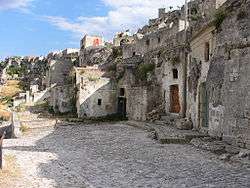 | |
| Type | Cultural |
| Criteria | iii, iv, v |
| Reference | 670 |
| UNESCO region | Europe and North America |
| Inscription history | |
| Inscription | 1993 (17th Session) |
Matera (Italian pronunciation: [maˈteːra] or locally [maˈtɛːra]) is a city and a province in the region of Basilicata, in Southern Italy. It is the capital of the province of Matera and the capital of Basilicata from 1663 to 1806. The town lies in a small canyon carved out by the Gravina.
Known as "la Città Sotterranea" (the Subterranean City), Matera is well known for its historical center called "Sassi", considered World Heritage Site by UNESCO since 1993, along with the Park of the Rupestrian Churches.
On October 17, 2014, Matera was declared Italian host of European Capital of Culture for 2019.[2]
History
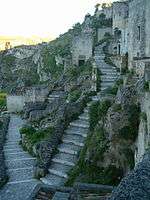
The area of what is now Matera has been settled since the Palaeolithic. The city was allegedly founded by the Romans in the 3rd century BC, with the name of Matheola after the consul Lucius Caecilius Metellus. In AD 664 Matera was conquered by the Lombards and became part of the Duchy of Benevento. In the 7th and 8th centuries the nearby grottos were colonized by both Benedictine and Basilian monastic institutions. The 9th and 10th centuries were characterized by the struggle between the Byzantines and the German emperors, including Louis II, who partially destroyed the city. After the settlement of the Normans in Apulia, Matera was ruled by William Iron-Arm from 1043.
After a short communal phase and a series of pestilences and earthquakes, the city in the 15th century became an Aragonese possession, and was given in fief to the barons of the Tramontano family. In 1514, however, the population rebelled against the oppression and killed Count Giovanni Carlo Tramontano. In the 17th century Matera was handed over to the Orsini and then became part of the Terre d'Otranto di Puglia. Later it was capital of Basilicata, a position it retained until 1806, when Joseph Bonaparte reassigned it to Potenza.
In 1927 it became capital of the province of Matera. On September 21, 1943, the Materani rose against the German occupation, the first Italian city to fight against the Wehrmacht.
Main sights
The Sassi (ancient town)
Matera has gained international fame for its ancient town, the "Sassi di Matera" (meaning "stones of Matera"). The Sassi originated in a prehistoric troglodyte settlement, and these dwellings are thought to be among the first ever human settlements in what is now Italy. The Sassi are habitations dug into the calcareous rock itself, which is characteristic of Basilicata and Apulia. Many of them are really little more than caverns, and in some parts of the Sassi a street lies on top of another group of dwellings. The ancient town grew up on one slope of the rocky ravine created by a river that is now a small stream, and this ravine is known locally as "la Gravina". In the 1950s, the government of Italy used force to relocate most of the population of the Sassi to areas of the developing modern city.
Until the late 1980s the Sassi was considered an area of poverty, since its dwellings were, and in most cases still are, uninhabitable. The present local administration, however, has become more tourism-oriented, and it has promoted the regeneration of the Sassi with the aid of the Italian government, UNESCO, and Hollywood. Today there are many thriving businesses, pubs, and hotels there.
 Church of San Agostino.
Church of San Agostino.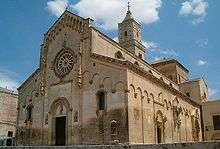
 Church of San Giovanni Battista.
Church of San Giovanni Battista.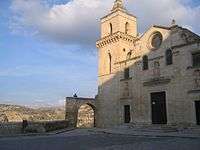 San Pietro Caveoso.
San Pietro Caveoso.
Monasteries and churches
Matera preserves a large and diverse collection of buildings related to the Christian faith, including a large number of rupestrian churches carved from the soft volcanic rock of the region.[3] These churches, which are also found in the neighboring region of Apulia, were listed in the 1998 World Monuments Watch by the World Monuments Fund.
Matera Cathedral (1268–1270) has been dedicated to Santa Maria della Bruna since 1389. Built in an Apulian Romanesque architectural style, the church has a 52 m tall bell tower, and next to the main gate is a statue of the Maria della Bruna, backed by those of Saints Peter and Paul. The main feature of the façade is the rose window, divided by sixteen small columns. The interior is on the Latin cross plan, with a nave and two aisles. The decoration is mainly from the 18th century Baroque restoration, but recently a Byzantine-style 14th-century fresco portraying the Last Judgment has been discovered.
Two other important churches in Matera, both dedicated to the Apostle Peter, are San Pietro Caveoso (in the Sasso Caveoso) and San Pietro Barisano (in the Sasso Barisano). San Pietro Barisano was recently restored in a project by the World Monuments Fund, funded by American Express. The main altar and the interior frescoes were cleaned, and missing pieces of moldings, reliefs, and other adornments were reconstructed from photographic archives or surrounding fragments.[4]
There are many other churches and monasteries dating back throughout the history of the Christian church. Some are simple caves with a single altar and maybe a fresco, often located on the opposite side of the ravine. Some are complex cave networks with large underground chambers, thought to have been used for meditation by the rupestric and cenobitic monks.
Cisterns and water collection
Matera was built above a deep ravine called Gravina of Matera that divides the territory into two areas. Matera was built such that it is hidden, but made it difficult to provide a water supply to its inhabitants. Early dwellers invested tremendous energy in building cisterns and systems of water channels.
The largest cistern has been found under Piazza Vittorio Veneto. With its solid pillars carved from the rock and a vault height of more than fifteen meters, it is a veritable water cathedral, which is navigable by boat. Like other cisterns in the town, it collected rainwater that was filtered and flowed in a controlled way to the Sassi.
There was also a large number of little superficial canals (rasole) that fed pools and hanging gardens. Moreover, many bell-shaped cisterns in dug houses were filled up by seepage. Later, when population increased, many of these cisterns were turned into houses and other kind of water-harvesting systems were realized.
Some of these more recent facilities have the shape of houses submerged in the earth.[5]
Other sights
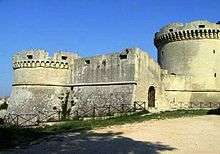
The Tramontano Castle, begun in the early 16th century by Gian Carlo Tramontano, Count of Matera, is probably the only other structure that is above ground of any great significance outside of the sassi. However, the construction remained unfinished after his assassination in the popular riot of 29 December 1514. It has three large towers, while twelve were probably included in the original design. During some restoration work in the main square of the town, workers came across what was believed to be the main footings of another castle tower. However, on further excavation large Roman cisterns were unearthed. Whole house structures were discovered where one can see how the people of that era lived. Found under the main square of the modern city was a large underground reservoir, complete with columns and a vaulted ceiling.
Culture
Cinema
Because of the ancient primeval-looking scenery in and around the Sassi, it has been used by filmmakers as the setting for ancient Jerusalem. The following famous biblical period motion pictures were filmed in Matera:
- Pier Paolo Pasolini's The Gospel According to St. Matthew (1964).
- Bruce Beresford's King David (1985).
- Mel Gibson's The Passion of the Christ (2004).
- Abel Ferrara's Mary (2005).
- Catherine Hardwicke's The Nativity Story (2006).
- Cyrus Nowrasteh's The Young Messiah (2016)
- Timur Bekmambetov's Ben-Hur (2016)
Other movies filmed in the city include:
- Mario Volpe's Le due sorelle (1950)
- Alberto Lattuada's La lupa (1953)
- Roberto Rossellini's Garibaldi (1961)
- Luigi Zampa's Roaring Years (1962)
- Brunello Rondi's Il demonio (1963)
- Nanni Loy's Made in Italy (1965)
- Francesco Rosi's More Than a Miracle (1967)
- Lucio Fulci's Don't Torture a Duckling (1972)
- Roberto Rossellini's Anno uno (1974)
- Paolo and Vittorio Taviani's Allonsanfàn (1974)
- Fernando Arrabal's The Tree of Guernica (1975)
- Carlo Di Palma's Qui comincia l'avventura (1975)
- Francesco Rosi's Christ Stopped at Eboli (1979)
- Francesco Rosi's Three Brothers (1981)
- Paolo and Vittorio Taviani's The Sun Also Shines at Night (1990)
- Giuseppe Tornatore's The Star Maker (1995)
- John Moore's The Omen (2006)
- Liu Jiang's Let's Get Married (2015)
- Patty Jenkins's Wonder Woman (2017)
Music
Matera appears in the music videos for the songs Sun Goes Down (2014) by Robin Schulz[6] and Spit Out the Bone (2016) by Metallica.[7]
European Capital of Culture
On 17 October 2014, Matera was declared European Capital of Culture for 2019, together with Bulgaria's second-largest city, Plovdiv.
Notable people
- Luigi De Canio, football manager
- Egidio Romualdo Duni, composer
- Cosimo Fusco, actor
- Giovanni di Matera, Benedictine monk and saint
- Francesco Mancini, footballer
- Gianvito Plasmati, footballer
- Francesco Carmelo Salerno, politician
- Franco Selvaggi, footballer
- Giovanni Carlo Tramontano, nobleman
Transportation
Matera is the terminal station of the Bari-Matera, a narrow gauge railroad managed by Ferrovie Appulo Lucane. The trip from Bari takes about one hour and thirty minutes The nearest airport is Bari airport and can be reached directly by train with a connection in Bari.
Matera is connected to the A14 Bologna-Taranto motorway through the SS99 national road. It is also served by the SS407, SS665 and SS106 national road.
Bus connection to Italy's main cities is provided by private firms.
Sports
- Football Club Matera
- Olimpia Matera, a basketball team
Twin towns
-
 Vigevano, Italy
Vigevano, Italy -
 Cartagena, Colombia
Cartagena, Colombia -
 Petra, Jordan
Petra, Jordan -
 Toms River, New Jersey, United States of America
Toms River, New Jersey, United States of America -
 Oulunsalo, Finland
Oulunsalo, Finland
See also
References
- ↑ Population data from Istat
- ↑ "Matera European Culture Capital 2019". gazzettadelsud.it. 17 October 2014. Retrieved 18 October 2014.
- ↑ Colin Amery and Brian Curran, Vanishing Histories, Harry N. Abrams, New York, NY: 2001, p. 44.
- ↑ World Monuments Fund - Rupestrian Churches of Puglia and the City of Matera
- ↑ Museo Laboratorio della Civiltà Contadina ONLUS (2014) [1st. Pub. 2007]. Water-harvesting systems of Matera, from Neolithic to the first half of XX century. Matera. ISBN 1500611565.
- ↑ Lilja Haefele (6 October 2014). "Robin Schulz "Sun Goes Down" (Lilja, dir.)". videostatic.com. Retrieved 11 November 2016.
- ↑ "Matera nel nuovo video dei Metallica". retecinemabasilicata.it. 18 November 2016. Retrieved 20 November 2016.
Other sources
- Giura Longo, Raffaele (1970). Sassi e secoli. Matera: BMG.
External links
- Travel Video promotion APT Basilicata (English)
- Video Sassi di Matera and Rupestral Churches (English)
- Video Festa della Bruna (English)
- UNESCO site
- Complete photo gallery of the Unesco photographer who published at the previous link
- Matera - The Festivity of the Madonna della Bruna
- Museo Laboratorio della Civiltà Contadina
- BBC News: Italian cave city goes hi-tech
- The rock-hewn churches map of Matera
- 360 HD Official Virtual Tour of Matera
- Roba Forestiera, documentary film, 2004, about the Sassi di Matera, premiered at Lucania Film Festival


